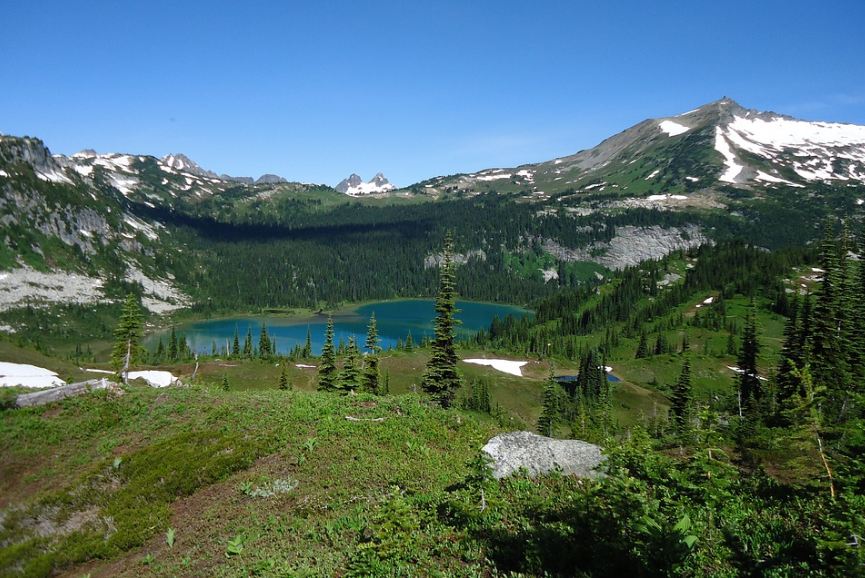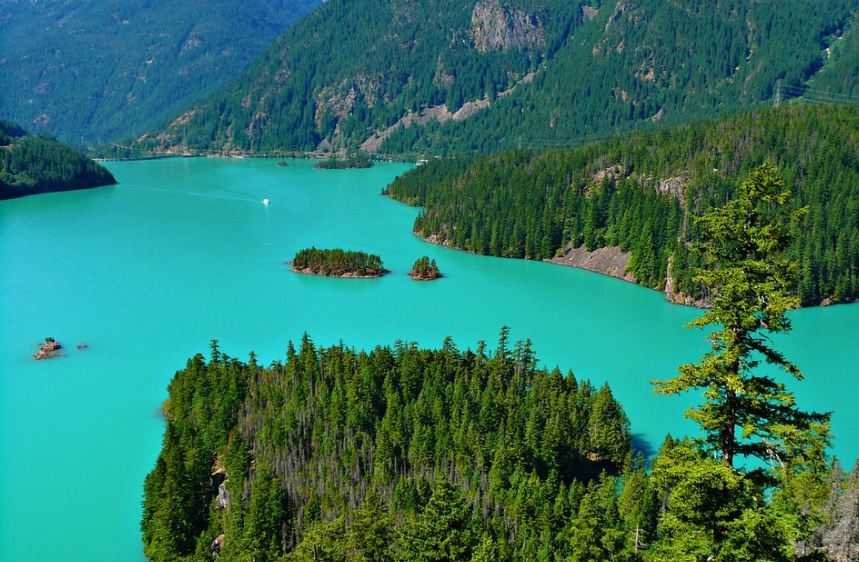With glaciated peaks rising from the densely forested valley, the North Cascade Range is situated at the park’s complex. It is often called the American Alps, with steep and rugged peaks, formed from durable granites and related rocks. Tallest peaks rise between 7000 to 9000 feet. Goode Mountain with an elevation of 9, 206 feet is the highest point at the center of the south unit while Mount Shuksan with 9, 131 feet is the highest at the north unit.
The North Cascade National Park is the largest unit over Ross Lake National Recreation Area and Lake Chelan National Recreation Area, which completes the North Cascades National Park Service Complex.
In the past, the vast mountain slopes are blanketed with some 300 glaciers and many snowfields. However, they have slowly diminished since the late 19th century, and some have entirely vanished probably as a result of climate change. Glaciers and snowfields that melt run down to hundreds of streams, lakes, and ponds in the park, especially within the Skagit River drainage system. On the southern part, they flow into the Stehekin River.
There are various climate patterns in the park complex, and it’s dependent on each location. It is wetter in the central and north-western regions because the Cascades create a climatic barrier to the prevailing moist weather systems towards eastward from the Pacific Ocean.
And due to these varied climate brought about by the different topography, vast ecological niches have been filled by a vast array of vegetation types. About 1600 plant species identified in the park, which includes hemlocks and Pacific silver firs in the forests on the western mountain slopes. There are western red cedars in the lower valleys, cottonwoods, and some other broad-leaved trees. Along streams grow some willow and alders.
Since eastern slopes are drier, only drought-resistant plants and trees thrive like Douglas firs, pines, and other firs. A plethora of ferns found in most mountain habitats and flowering plants like daisies and campions bloom from the deep mountain valleys to high alpine meadows. The woodland areas with moist climate are home to hundreds of species of mushrooms.
HISTORY
There are at least 23 historic cultural landscapes remnants found within the park boundaries. The park consisted of historical treasures, including abandoned mines, and historic hotels that capture the spirit of rustic recreation in wilderness areas. These structures have regular inventory and monitoring for preservation for future generations.
The Paleo-Indian Native Americans initially inhabited North Cascades National Park, and by the time European American explorers arrived, the park was home to Skagit tribes. Fur trappers and some British and American companies vying for control over the fur trade have visited the region during the early 19th century. Miners and homesteaders followed, making a permanent home for themselves in the North Cascades.
During the 1920s, human activities had a significant impact on the region, such as building dams in the Skagit River valley to generate hydroelectric power. Environmentalists campaigned to preserve the remaining wilderness, culminating on October 2, 1968, with President Lyndon B. Johnson signing the bill creating the 504,000-acre North Cascades National Park.
ACTIVITIES
- Cascades Pass Trail
Have a great day hike at the Cascade Pass Trail with spectacular views of peaks and glaciers. The trail steadily climbs to the pass, offering a scenic view of peaks of Eldorado, Johannesburg, Magic, Mixup, and McGregor. This trail makes the shortest and easiest access in the park to the alpine environment making it one of the most popular trails.
- Washington Road Trip
There is only one primary road – Scenic Highway 20, passing through the park, making tours easier. Covering 140 miles, the North Cascades Scenic Highway makes up part of the Cascade Loop, a popular multi-day Washington road trip. The highway skirts the Skagit River through the park. Taking a road trip along the North Cascades Highway is one best way to experience the national park.
- Washington Pass Overlook
Do not miss the Washington Pass Overlook on your North Cascades National park tour. With its towering, jagged peaks, and intensity of colors, visitors’ eyes and souls are captured.
The most subject for photographs are best taken at the Liberty Bell Group of nearly 8,000-foot spires rises dramatically. You can pass through a short quarter-mile loop trail that can lead to different vantage points. Blue Lake is just on the other side.
The highest point of the road is it at 5,500 feet. It is also the dividing line between eastern and western Washington.
- Ross Lake
Ross Lake, 23 miles long, and averages 1.5 miles wide and spans the U.S. and Canadian border, is one of the Pacific Northwest’s largest reservoirs.
There is only reach the Ross Lake by road on its north end in B.C. Paddlers can launch in at Colonial Creek Campground, Diablo Lake, to reach Ross Lake on the east side of Diablo.



